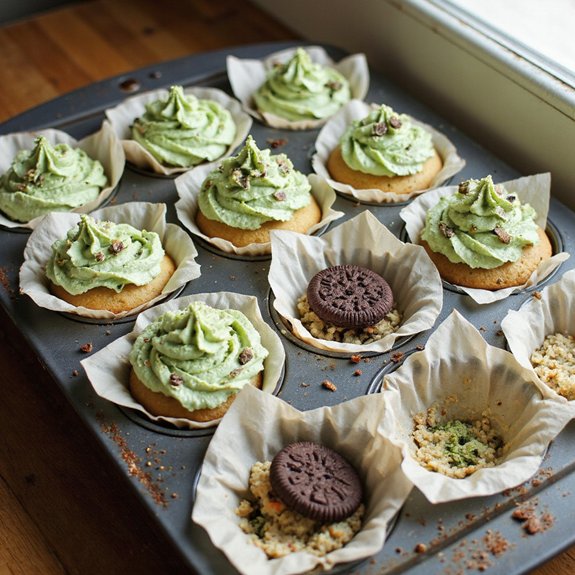Picture cracking into a sugar-dusted cookie, colors from rainbow sprinkles peeking through, and a soft, buttery crumb giving way to a warm ribbon of silky, salt-kissed fudge.
Imagine the kitchen filling with the cozy aroma of vanilla and caramelized edges, the kind of scent that hugs you after a long day.
These cookies matter to me because they’re pure comfort with a playful twist—simple enough for a Tuesday treat, impressive enough for a celebration, and perfect for bake sales, busy weeknights, or Sunday suppers when you want something sweet without fuss.
When my son came home deflated after a tough test, a batch of these brought the smiles back—familiar sugar cookie on the outside, a surprise of chocolate in the middle, just enough magic to turn the evening around.
They chill quickly, bake fast, and stash beautifully for later.
Ready? Let’s cook!
Why You’ll Love It
- Delivers a gooey, molten fudge center in every bite
- Balances chewy sugar cookie with rich chocolate filling
- Uses simple pantry staples and basic kitchen equipment
- Freezes beautifully for bake-on-demand cookie cravings
- Offers customizable sweetness with chocolate or sprinkle swaps
Ingredients
- 1 cup unsalted butter, softened — room temp for easy creaming
- 1 cup granulated sugar — fine texture for even mixing
- 1/2 cup light brown sugar, packed — adds moisture and caramel notes
- 2 large eggs, room temperature — blends better into batter
- 2 teaspoons vanilla extract — pure extract for best flavor
- 2 3/4 cups all-purpose flour — measure by weight if possible
- 1/2 teaspoon baking soda — fresh, not expired
- 1/2 teaspoon baking powder — aluminum-free preferred
- 1/2 teaspoon fine sea salt — balances sweetness
- 1/2 cup rainbow sprinkles (optional) — jimmies hold shape best
- 1 cup semi-sweet chocolate chips — good-melt brand
- 1/2 cup sweetened condensed milk — not evaporated milk
- 2 tablespoons unsalted butter, cubed — for fudge mixture
- 1/4 teaspoon fine sea salt, for fudge — enhances chocolate
- 1/2 teaspoon vanilla extract, for fudge — rounds out fudge flavor
- 1/4 cup granulated sugar, for rolling (optional) — light sparkle and crunch
Step-by-Step Method
Line the Pans
Line two baking sheets with silicone mats or parchment. Clear space in the fridge for chilling bowls and shaped dough. Set out a wire rack for cooling. Gather a 1.5-tablespoon scoop and a teaspoon. Having equipment ready keeps the pace smooth once mixtures are warm or chilled and helps prevent fudge from softening while shaping.
Melt the Fudge Base
Combine chocolate chips, sweetened condensed milk, 2 tablespoons cubed butter, and 1/4 teaspoon fine sea salt in a microwave-safe bowl. Microwave in 20–30 second bursts, stirring well between each.
Heat just until smooth and glossy. Avoid overheating to prevent graininess. The residual heat finishes melting as you stir, so stop while a few small bits remain.
Flavor & Chill the Fudge
Stir in 1/2 teaspoon vanilla extract until fully incorporated. Let the mixture cool on the counter for 5–10 minutes to thicken slightly.
Transfer to the refrigerator until scoopable, about 20 minutes. Keep it cold but pliable. If it firms too much, rest at room temperature briefly so you can scoop clean, compact teaspoon-size balls.
Cream the Butter & Sugars
In a large bowl, beat 1 cup softened unsalted butter with granulated sugar and packed light brown sugar. Mix on medium speed for 2–3 minutes until pale, light, and fluffy. Scrape the bowl and beater.
Proper creaming incorporates air, yielding tender cookies with delicate edges and a soft center that cradles the fudge filling.
Add Eggs & Vanilla
Beat in the eggs one at a time, mixing just until each disappears before adding the next. Blend in 2 teaspoons vanilla extract. Scrape the bowl thoroughly to prevent streaks of butter or sugar.
Avoid overbeating at this stage to keep the dough tender. The mixture should look smooth, slightly thick, and well emulsified.
Whisk the Dry Ingredients
In a separate bowl, whisk all-purpose flour, baking soda, baking powder, and 1/2 teaspoon fine sea salt. Break up any lumps for even distribution. Whisking prevents pockets of leavening and ensures consistent rise.
Having the dry mix ready streamlines combining, reducing the time the wet batter sits, which helps maintain ideal texture.
Bring the Dough Together
Add the dry ingredients to the wet in two additions. Mix on low just until a soft dough forms and no dry streaks remain. Don’t overmix.
Overworking develops gluten and can toughen cookies. Fold in rainbow sprinkles if using, distributing evenly. The dough should be supple and slightly tacky but able to hold scooped shapes.
Chill Briefly to Firm
Cover the bowl tightly and chill the dough for 15 minutes. This short rest firms the butter and relaxes any developing gluten. If the dough feels sticky after chilling, give it 5 extra minutes.
Lightly flour your hands only if needed. Meanwhile, preheat the oven to 350°F (175°C) so it’s ready for baking.
Portion the Cookie Dough
Using a 1.5-tablespoon scoop, portion 24 level mounds of dough. Flatten each into a thick disk with your palm. Work quickly to keep the dough cool.
Arrange disks on a lined sheet or plate for easy assembly. Keeping portions uniform ensures even baking and consistent space for the fudge center.
Scoop the Fudge Centers
Scoop 24 small, teaspoon-size balls of the chilled fudge mixture. Keep them on a chilled plate or small tray in the refrigerator as you work.
Cold fudge is easier to wrap without smearing. If the fudge softens, return it to the fridge for a few minutes. Aim for compact balls to prevent leakage.
Wrap & Seal the Cores
Place one fudge ball in the center of a dough disk. Wrap the dough up and around, pinching seams firmly to seal completely.
Roll gently between your palms to form a smooth ball. If any fudge peeks through, patch with a bit of dough. Proper sealing keeps the core hidden and molten after baking.
Sugar-Coat and Arrange
Roll each dough ball lightly in granulated sugar if desired. This adds sparkle and a delicate crust.
Set balls on the prepared baking sheets spaced about 2 inches apart to allow spread. Keep the second tray chilled while the first bakes. Chilled dough maintains shape and helps prevent the fudge from leaking.
Bake Until Just Set
Bake one sheet at a time for 9–11 minutes. Look for set edges and pale, slightly crackled tops; centers should appear soft.
Avoid overbaking to preserve a tender, chewy texture and gooey core. Rotate the sheet once if needed for even color. Remove promptly when they meet visual cues.
Cool and Set the Centers
Cool cookies on the sheet for 5 minutes to finish setting. Transfer to a wire rack to cool completely so the fudge centers firm to a luscious, sliceable texture.
Patience prevents collapsed cookies or oozing cores. Once cool, store airtight for 3–4 days. For extra softness, underbake slightly and rely on carryover heat.
Ingredient Swaps
- Butter: Use vegan butter or refined coconut oil (firm) for dairy-free; margarine works on a budget.
- Sugar: Substitute coconut sugar for brown sugar notes; all white sugar works if needed.
- Eggs: Replace each egg with 1/4 cup unsweetened applesauce, 3 tablespoons aquafaba, or a flax egg (1 tbsp ground flax + 3 tbsp water) for egg-free.
- Flour: Use a 1:1 gluten-free baking blend; add 1–2 teaspoons milk or water if dough seems dry.
- Sprinkles: Omit or use dye-free/natural sprinkles; chopped nuts or cocoa nibs are a regional/budget alternative.
- Chocolate chips: Swap with milk or dark chocolate, chopped chocolate bars, or budget baking wafers; dairy-free chips for vegan.
- Sweetened condensed milk (fudge): Use sweetened condensed coconut milk for dairy-free; for budget, make quick DIY by simmering milk and sugar until reduced by half.
- Vanilla: Use vanilla paste or regional alternatives like almond extract (1/2–3/4 amount) or a splash of rum extract.
- Rolling sugar: Use turbinado for crunch, cinnamon sugar for a snickerdoodle vibe, or skip to reduce sweetness.
- Salt: Sea salt can be replaced with kosher (slightly increase) or table salt (use a pinch less).
You Must Know
– Doneness • If edges look set but centers seem too pale, remove the tray anyway; carryover heat finishes them.
Why: overbrowning ruins the soft chew.
Visual cue: matte edges with faint surface cracking; pull at 9–10 minutes, not waiting for golden tops.
– Troubleshoot • When fudge cores leak out, pinch-seal any visible seams and re-chill shaped dough 10–15 minutes before the oven.
Why: warmer dough thins and splits.
Sensory anchor: dough should feel cool and slightly firm; fudge scoops should resist gentle pressure.
– Scale • For larger bakery-style cookies, portion 3 tablespoons dough and 2 teaspoons fudge; add 2–3 minutes to oven time.
Why: keeps filling-to-cookie ratio balanced.
Visual cue: 2.5–3 inch spread, same pale tops with set edges.
– Flavor Boost • To deepen chocolate notes, stir 1/2–1 teaspoon instant espresso into the warm fudge or add 1/2 teaspoon almond extract to dough.
Why: enhances perceived cocoa and complexity.
Taste check: fudge should read chocolate-first, not coffee-forward.
– Make-Ahead • For best texture day 2–3, store with a slice of bread in an airtight container.
Why: bread donates moisture, preventing dryness.
Time anchor: swap the bread slice every 24 hours to avoid staling aromas transferring.
Serving Tips
- Serve warm with vanilla ice cream; the molten fudge creates a sundae vibe.
- Pair with cold milk or a cappuccino to balance sweetness.
- Drizzle with warm salted caramel and a sprinkle of sea salt.
- Plate with fresh berries for a bright, tangy contrast.
- Crumble over chocolate pudding or mousse for texture and surprise bites.
Storage & Make-Ahead
Dough can be made 2–3 days ahead; keep tightly wrapped and chilled.
Shaped, unbaked stuffed balls hold 24–48 hours in the fridge.
Baked cookies stay fresh airtight at room temperature 3–4 days or refrigerated up to a week.
Freeze unbaked stuffed balls up to 2 months; bake from frozen, adding 1–2 minutes.
Reheating
Reheat gently.
Microwave 8–12 seconds for gooey centers.
Oven at 300°F for 5–7 minutes on a sheet.
Stovetop skillet low heat, covered 2–3 minutes.
Avoid high heat to prevent drying.
State-Fair Bake-Sale Favorite
Once you’ve warmed a cookie back to gooey perfection, picture a whole tray of them glittering under fairground lights. I set them out on checkered cloth, sugar-kissed and jewel-speckled with sprinkles, and watch hands hover.
One bite, and the soft vanilla crumb yields to a molten fudge heart—people pause, smile, and reach for another.
I price them fair, stack them in neat pyramids, and tuck napkins beside a handwritten sign: “Fudge Core Surprise.” The scent—butter, cocoa, warm sugar—pulls a line from the lemonade stand.
I bring extra, because word spreads fast. Kids point at the crackled tops; grandparents ask for the recipe. I wrap them snug for the walk home, feeling the tray grow lighter, the evening sweeter with every sale.
Final Thoughts
Ready to bake some joy? Give these Fudge Core Surprise Sugar Cookies a try, and feel free to tweak the sprinkles or chocolate to make them your own!
Frequently Asked Questions
Can I Make Them Gluten-Free Without Altering Texture?
Yes—you can. I swap in a 1:1 gluten-free baking flour with xanthan gum, add 1 tablespoon cornstarch, and chill the dough longer. The cookies bake tender, edges whisper-crisp, centers gooey, hiding that molten fudge heart.
How Do Altitude Adjustments Affect Bake Time?
At high altitude, I bake longer by 1–3 minutes and watch for set edges. I raise oven temp 15–25°F, reduce sugar slightly, add a splash more liquid, and keep dough chilled—fudge stays molten, cookies hold shape.
What’s the Best Way to Ship These Cookies?
Ship them cooled, day-old, individually wrapped, then double-bagged. I nestle pairs back-to-back, cushion with crumpled parchment, pack snug in a tin, then box with bubble wrap. I choose two-day shipping; winter’s perfect—summer needs cold packs.
Are There Egg-Free Binding Alternatives That Work?
Yes—use 3 tablespoons aquafaba per egg, or 1 tablespoon ground flax mixed with 3 tablespoons water. I whisk until thick and silky, fold gently, and feel the dough turn plush, sealing fudgy centers without crumbling.
How Can I Prevent Fudge Cores From Crystallizing?
Keep sugar from crystallizing by melting gently, stirring minimally, and adding corn syrup or a touch of acid. I warm ingredients evenly, cool undisturbed, and seal dough quickly—silky fudge nestles inside like satin, not gritty hail.

Fudge Core Surprise Sugar Cookies
Equipment
- 1 large mixing bowl
- 1 large mixing bowl
- 1 medium microwave-safe bowl
- 1 Stand mixer or hand mixer
- 1 Whisk
- 1 Rubber spatula
- 1 Baking sheet
- 1 Baking sheet
- 1 silicone baking mat or parchment paper
- 1 silicone baking mat or parchment paper
- 1 Cookie scoop 1.5 tablespoon
- 1 Wire rack
- 1 Cooling rack
- 1 plastic wrap roll
Ingredients
- 1 cup unsalted butter softened
- 1 cup granulated sugar
- 1/2 cup light brown sugar packed
- 2 large eggs room temperature
- 2 teaspoon vanilla extract
- 2 3/4 cup all-purpose flour
- 1/2 teaspoon baking soda
- 1/2 teaspoon baking powder
- 1/2 teaspoon fine sea salt
- 1/2 cup rainbow sprinkles optional
- 1 cup semi-sweet chocolate chips
- 1/2 cup sweetened condensed milk
- 2 tablespoon unsalted butter cubed
- 1/4 teaspoon fine sea salt for fudge
- 1/2 teaspoon vanilla extract for fudge
- 1/4 cup granulated sugar for rolling, optional
Instructions
- Line two baking sheets with silicone mats or parchment and set aside.
- In a medium microwave-safe bowl combine chocolate chips, sweetened condensed milk, 2 tablespoons butter, and 1/4 teaspoon salt and microwave in 20–30 second bursts, stirring until smooth.
- Stir 1/2 teaspoon vanilla into the fudge mixture, let cool 5–10 minutes, and refrigerate until scoopable, about 20 minutes.
- In a large bowl beat 1 cup softened butter with granulated sugar and brown sugar until light and fluffy, 2–3 minutes.
- Beat in eggs one at a time, then mix in 2 teaspoons vanilla until combined.
- In another bowl whisk flour, baking soda, baking powder, and 1/2 teaspoon salt.
- Add dry ingredients to the wet in two additions, mixing just until a soft dough forms.
- Fold in sprinkles if using, then cover the bowl and chill 15 minutes to firm slightly.
- Preheat oven to 350°F (175°C).
- Scoop 24 level portions of cookie dough using a 1.5 tablespoon scoop and flatten each into a thick disk.
- Scoop 24 small teaspoon-size balls of the chilled fudge and keep them cold.
- Place one fudge ball in the center of a dough disk, wrap the dough around to seal, and roll into a smooth ball.
- Roll each ball lightly in granulated sugar if desired and set on prepared sheets spaced 2 inches apart.
- Bake one sheet at a time for 9–11 minutes until edges are set and tops are pale and slightly crackled.
- Cool on the sheet for 5 minutes, then transfer cookies to a wire rack to cool completely so the fudge centers set.





